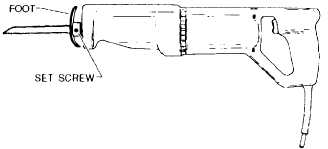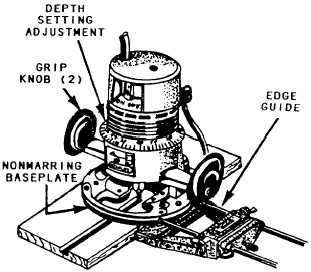gripping the tool, which will be affected somewhat by the particular tool you are using. On some tools, for example, you will find guiding easier if you apply some downward pressure on the tool as you move it forward. If you don't use a firm grip, the tool will tend to vibrate excessively and roughen the cut. Do not force the cutting faster than the design of the blade allows or you will break the blade.
You can make a pocket cut with a saber saw just like you can with a circular saw, although you need to drill a starter hole to begin work. A saber saw can also make bevel-angle and curve cuts.
Observe the following safety precautions when operating the saber saw:
Before working with the saber saw, be sure to remove your rings, watches, bracelets, and other jewelry.
If you are wearing long sleeves, roll them up.
Be sure the saber saw is properly grounded.
Use the proper saw blade for the work to be done, and ensure the blade is securely locked in place.
Be sure the material to be cut is free of any obstructions.
Keep your full attention focused on the work being performed.
Grip the handle of the saw firmly. Control the forward and turning movements with your free hand on the front guide.
To start a cut, place the forward edge of the saw base on the edge of the material being worked, start the motor, and move the blade into the material.
Portable Reciprocating Saw
The portable reciprocating saw (saw-all) (figure 3-20) is a heavy-duty power tool that you can use for a variety of woodworking maintenance work, remodeling, and roughing-in jobs. You can use it to cut rectangular openings, curved openings, along straight or curved lines, and flush.
Blades for reciprocating saws are made in a great variety of sizes and shapes. They vary in length from 2 1/2 to 12 inches and are made of high-speed steel or carbon steel. They have cutting edges similar to those shown in figure 3-19.

Figure 3-20.-Reciprocating saw.
Before operating this saw, be sure you are using a blade that is right for the job. The manufacturer's instruction manual shows the proper saw blade to use for a particular material. The blade must be pushed securely into the opening provided. Rock it slightly to ensure a correct fit, then tighten the setscrew.
To start a cut, place the saw blade near the material to be cut. Then, start the motor and move the blade into the material. Keep the cutting pressure constant, but do not overload the saw motor. Never reach underneath the material being cut.
Observe the following safety precautions when operating a reciprocating saw:
Disconnect the saw when changing blades or making adjustments.

Figure 3-21.-Portable router with edge guide.
Continue Reading